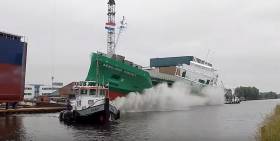Displaying items by tag: Arklow Cadet
#NewBuilds - A newbuild for an Irish shipping company was launched today from the same Dutch yard that delivered another vessel recently to Norwegian interests, writes Jehan Ashmore.
M.V. Arklow Cadet is not only the first of 10 in a new 'C' class series for Arklow Shipping Ltd but also the first to carry that name when she was launched this morning from Ferus Smit's Dutch yard. The 5,000 deadweight tons newbuild with yard no. 424 took to the waters at Westerbroek near Groningen.
In recent years the steady stream of ships built at this yard along with Royal Bodewes (which is located only a few kms away) have all been completed for ASL's division, Arklow Shipping Nederland B..V. On this occasion, Arklow Cadet a single hold (222.000cft) cargoship will be directly operated by Irish headquartered ASL and registered in the homeport of Arklow.
Arklow Cadet is under the 3000 gross tons limit and has a 1A ice-class notation. Propuslion is from a 1740 kW MaK engine with a single ducted propeller.





























































